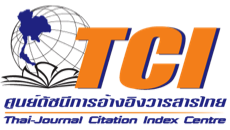ผลของความสามารถด้านการคิดสร้างสรรค์จากการเรียนด้วยหนังสืออิเล็กทรอนิกส์ร่วมกับการสอนแบบซินเนคติคส์ ของนักเรียนระดับชั้นประถมศึกษาปีที่ 6 ที่มีแบบการเรียนรู้ที่ต่างกัน (The Effect of E-book with Synectics Instructional Model on the Creative Thinking of Sixth-Grade Students with Different Learning Styles)
คำสำคัญ:
ซินเนคติคส์, หนังสืออิเล็กทรอนิกส์, ความคิดสร้างสรรค์บทคัดย่อ
การวิจัยครั้งนี้มีวัตถุประสงค์เพื่อ 1) เพื่อเปรียบเทียบความสามารถด้านความคิดสร้างสรรค์ก่อนและหลังของนักเรียนที่มีรูปแบบการเรียนรู้ต่างกัน 2) เพื่อเปรียบเทียบความสามารถด้านความคิดสร้างสรรค์ระหว่างกลุ่มของนักเรียนที่มีรูปแบบการเรียนรู้ต่างกัน 3) เพื่อศึกษาความพึงพอใจของนักเรียนที่มีต่อหนังสืออิเล็กทรอนิกส์ ร่วมกับการสอนแบบซินเนคติคส์ กลุ่มตัวอย่างคือ นักเรียนระดับชั้นประถมศึกษาปีที่ 6 โรงเรียนอนุบาลสวนผึ้ง ปีการศึกษา 2563 ใช้วิธีการสุ่มแบ่งกลุ่ม จำนวน 27 คน โดยแบ่งกลุ่มผู้เรียนเป็น 3 กลุ่ม ตามรูปแบบการเรียนรู้ คือ 1) การเรียนรู้ทางสายตา 2) การเรียนรู้ทางโสตประสาท 3) การเรียนรู้ทางการรับสัมผัสและการเคลื่อนไหว เครื่องมือที่ใช้ในงานวิจัย 1) แบบประเมินรูปแบบการเรียนรู้ 2) แผนการจัดการเรียนรู้ 3) หนังสืออิเล็กทรอนิกส์ วิชาทัศนศิลป์ 4) แบบประเมินความสามารถด้านความคิดสร้างสรรค์ 5) แบบสอบถามวัดความพึงพอใจของนักเรียน ผลการวิจัยพบว่า 1) ผลการเปรียบเทียบความสามารถด้านความคิดสร้างสรรค์ก่อนและหลังของนักเรียนระดับชั้นประถมศึกษาปีที่ 6 ที่มีรูปแบบการเรียนรู้ต่างกัน โดยการเรียนด้วยหนังสืออิเล็กทรอนิกส์ ร่วมกับการสอนแบบซินเนคติคส์ พบว่าหลังเรียนสูงกว่าก่อนเรียน อย่างมีนัยสำคัญทางสถิติที่ระดับ .05 2) ผลการเปรียบเทียบความสามารถด้านความคิดสร้างสรรค์ระหว่างกลุ่มของนักเรียนระดับชั้นประถมศึกษาปีที่ 6 ที่มีรูปแบบการเรียนรู้ต่างกัน โดยการเรียนด้วยหนังสืออิเล็กทรอนิกส์ ร่วมกับการสอนแบบซินเนคติคส์ พบว่าไม่มีความแตกต่างกันอย่างมีนัยสำคัญทางสถิติที่ระดับ .05 3) มีค่าเฉลี่ยความพึงพอใจของนักเรียนที่มีต่อหนังสืออิเล็กทรอนิกส์ ร่วมกับการสอนแบบซินเนคติคส์ พบว่ามีค่าเฉลี่ยความพึงพอใจอยู่ในระดับมาก
References
2. Beasiri, S. (2007). A Development of a Training Program for Undergraduate Students with Art Activities to Develop Creative Thinking and Productive Skills. Doctor of Philosophy Program in Higher Education Graduate School Chulalongkorn University. (in Thai)
3. Bruce, J. & Marsha, W. (1996). Models of Teaching (5th ed.). Boston: Allyn and Bacon.
4. Chuenarrom, W. (2003). Development of the Performance Evaluation Form of Arts Learning Strand: Visual Art, Second Level. Master of Education in Research Graduate School Chulalongkorn University. (in Thai)
5. Educational Quality Assurance and Research Administration Division. (2016). Blueprint Thailand 4.0 Model : Propel Thailand's Economic and Social Development Towards Stability, Prosperity, and Sustainability. [Online]. Retrieved February 7, 2019, from https://www.nstda.or.th/home/knowledge_post/blueprint-thailand-4/
6. Gordon, W. J. J. (1961). Synectics: The Development of Creative Capacity. New York: Harper and Row.
7. Ketlekha, W. (2014). A Study of Learning Achievement on Learning Unit of Creative art Thinking and Creativity of Prathomsuksa Four Students by Synectices Instruction and Invention Surrealism Art. Master of Curriculum and Instruction Program Graduate School Ratchasima Rajabhat University. (in Thai)
8. Kitsamut, J. (2014). A Development of Interactive Multimedia Using Synectics Instructional Process to Enhance Creative Thinking in Product Design for High School Students, Art Design Section, Assumption School. Master of Science in Industrial Graduate School King Mongkut's University of Technology Thonburi. (in Thai)
9. Munkham, S and Moonkham, O. (2002). 21 Methods of Learning: to Develop Thinking Processes. Bangkok: Parbpim Limited Partnership. (in Thai)
10. Office of Educational Reform and Office of the National Education Commission. (1999). National Education Act of B.E. 2542 (1999). Bangkok: Office of the National Education Commission. (in Thai)
11. Office of the Education Council. (2017). National Education Plan (2017-2036). Bangkok: Office of the Education Council. (in Thai)
12. Panich, V. (2014). Build Learning into the 21st Century. 2nd ed. Bangkok: Siam Commercial Foundation. (in Thai)
13. Po Ngern, W. (2010). The development of a Knowledge Management System of Thai Art to Enhance Art Students' a Creative Thinking for Designing. Doctor of Philosophy Program in Higher Education Graduate School Chulalongkorn University. (in Thai)
14. Pummalai, M. (2012). Education in Thailand in the New Age, and Why? ... Popular to Use an E-book. [Online]. Retrieved February 7, 2019, from https://www.gotoknow.org/posts/493357
15. Srifa, P. (2008). E-Book: Talking Books. Bangkok: Than Books. (in Thai)
16. Tangthanathanit, P. (2009). "E-book" a New Alternative to Electronic Instructional Media. [Online]. Retrieved February 7, 2019, from https://www.thairath.co.th/content/537444
17. Thammabus, M. (2001). “Learning Styles” Academic Journal 4(10): 6-14. (in Thai)
18. Yaemcharun, T. (2016). Cognitive Engagement and Learning Effectiveness with Interactive E-book. Master of Science Program Thesis Program in Information Technology in Business Graduate School Chulalongkorn University. (in Thai)




